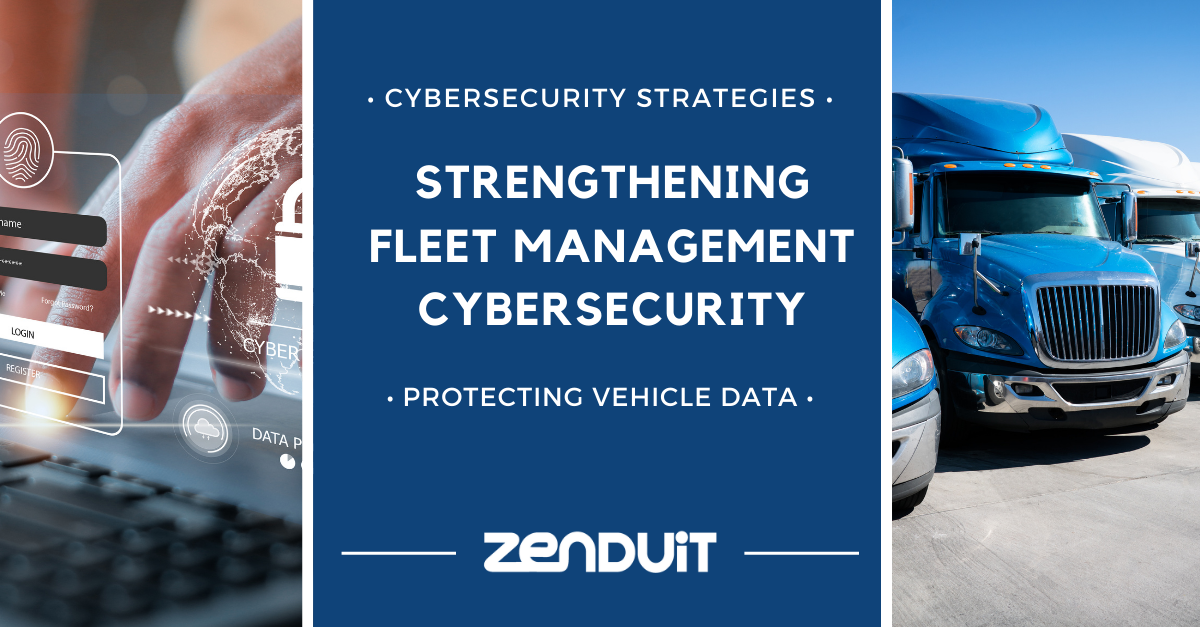How has new tech like IoT transformed the way we manage fleets?
They’ve made operations much more efficient and allowed us to handle fleet issues in real-time. But there’s a catch—these changes bring new cybersecurity threats that could put your data and operations at risk.
In fact, cyber threats are now a major concern across all sectors. In 2023, the average cost of a data breach was a whopping $4.45 million! These breaches are expensive and can damage a company’s reputation, making it harder to maintain trust with customers.
In this post, we’ll explore practical strategies for cybersecurity in fleet management, and highlight innovative technologies that enhance data protection. We want to empower you with knowledge and tools that fortify your operations against cyber threats, ensuring your data drives your business forward safely and reliably.
Understanding the Threat Landscape
With increased connectivity comes the need for robust measures to safeguard sensitive telematics data and driver information. Each type of cybersecurity threat carries potential consequences that could significantly impact operations, safety, and financial stability.
Common Threats:
- Hacking: Unauthorized access to fleet management systems can lead to the manipulation or theft of data. Hackers may target these systems to gain control over vehicle operations or to access sensitive information.
- Phishing: This involves fraudulent communication, often via email, that appears to come from a reputable source. Its purpose is to steal sensitive data like login credentials or other personal information. Fleet management personnel may receive seemingly legitimate emails that, if acted upon, could compromise the entire system.
- Ransomware: This type of malware blocks access to a system’s data, threatening to publish or delete it unless a ransom is paid. Ransomware can immobilize fleet operations, leading to significant downtime and disruption.
Potential Consequences:
- Data Loss: The loss of critical data, such as vehicle tracking information, driver details, and customer data, can disrupt operations and require significant time and resources to recover. For example, AMAG Pharmaceuticals experienced critical data loss when a mishap with their cloud Drive led to the disappearance of crucial HR-related files. The recovery of such data often demands substantial time and resources, highlighting the need for robust data protection and backup strategies in fleet management operations.
- Financial Damage: Cybersecurity breaches often lead to direct financial loss from theft of financial information or paying ransoms. Indirect costs include regulatory fines, legal fees, and costs associated with repairing damaged systems and restoring lost data.
- Compromised Safety: If fleet management systems that control or monitor vehicle functions are compromised, it could lead to safety hazards on the road. Unauthorized changes to vehicle systems could potentially lead to accidents, endangering lives and causing property damage.
Understanding these threats and potential consequences is the first step in crafting an effective strategy for cybersecurity in fleet management that not only protects against attacks but also minimizes the impact should a breach occur.
Core Strategies for Cybersecurity in Fleet Management
As fleet management continues to evolve with technology, so too must our approaches to securing these critical systems against ever-changing cyber threats.
Implementing robust cybersecurity measures can drastically reduce the likelihood of a breach and mitigate the potential impacts if one does occur. Here are three core strategies that are essential in protecting fleet management systems:
Data Encryption:
Encrypting data is like putting your most valuable assets in a safe. It transforms readable data into a coded form that can only be accessed or decrypted with the correct key. By encrypting data related to vehicle telematics and driver information, businesses ensure that even if unauthorized parties access the data, they cannot interpret or misuse it. This is particularly crucial for data transmitted over networks, where interception risks are higher.
Secure Software Interfaces:
When it comes to keeping your fleet management systems safe, it’s all about ensuring that only the right eyes are on your sensitive data. Regular software updates and patches are not just routine maintenance—they’re your best defense against the latest cyber threats, making sure that vulnerabilities are patched before they can be exploited.
Adding a layer of two-factor authentication (2FA) really bolsters your security. It’s like having a double-check system; users must provide two types of identification to access the system, dramatically lowering the risk of unwanted intrusions.
Take, for example, ZenduiT’s offerings—ZendIoT and ZenduOne – Work. These tools are tailor-made for secure fleet management. ZendIoT connects and manages IoT devices with top-notch security protocols to shield your data. ZenduOne – Work, on the other hand, makes managing your workflows smooth while locking down access to sensitive information. Both solutions are continuously updated to keep up with security best practices, ensuring your fleet operates safely and efficiently. They show just how serious ZenduiT is about keeping your data under lock and key, backed by the latest tech to prevent data loss.
Regular Security Audits:
Conducting regular security audits is akin to regularly checking the locks on your doors. These audits assess the effectiveness of existing security measures and identify potential vulnerabilities within the fleet management systems. By regularly reviewing and evaluating the security posture, companies can stay one step ahead of potential threats. Security audits often include penetration testing, where security experts attempt to breach the system defenses using the same techniques as cybercriminals. This proactive approach allows businesses to patch discovered weaknesses before they can be exploited maliciously.
Implementing a Cybersecurity Framework
A robust cybersecurity framework encompasses comprehensive policy development, thorough employee training, and a well-prepared incident response plan. Here’s how to implement these critical components effectively:
Coaching Organizations to Develop Cybersecurity Policies
Creating comprehensive policies for cybersecurity in fleet management that are tailored to each fleet can help establish clear guidelines on how to handle and protect sensitive information, and define roles and responsibilities within the organization.
These policies should cover various aspects, including:
- Data encryption
- Access controls
- Regular security assessments
- Ensure that policies are scalable and adaptable to new cybersecurity challenges as the fleet management landscape evolves
Regularly updating your policies to incorporate new technologies, threat vectors, and regulatory requirements will also help you maintain strong security.
Employee Training:
The human element often poses one of the biggest risks in cybersecurity. Engaging, regular training helps in cultivating a security-first culture within the organization, significantly reducing the risk of human error leading to security breaches.
Training should include recognizing phishing attempts, securing personal devices used in work contexts, and understanding the importance of using strong, unique passwords for accessing system interfaces.
Incident Response Planning:
A well-rounded cybersecurity framework not only safeguards digital assets, but can also bolster resilience against the increasingly sophisticated landscape of cyber threats. This plan should outline specific steps to be taken in the event of a cybersecurity breach, including:
- How to contain and mitigate the breach
- Who to notify (including regulatory bodies if necessary)
- How to assess and repair the damage caused
- Protocols for communicating with external stakeholders, such as customers and partners, to maintain transparency and trust
Leveraging Technology for Enhanced Security
By integrating advanced technologies and telematics security features, fleet management can not only protect assets and data but also enhance operational efficiency.
These technologies provide powerful tools for preventing, detecting, and responding to cyber threats, thereby safeguarding the future of fleet operations in an increasingly digital world.
Advanced Security Solutions:
- Blockchain Technology: Blockchain can revolutionize fleet management security by providing a decentralized and tamper-evident ledger for recording transactions and data exchanges within the fleet operations. This technology ensures data integrity and prevents unauthorized access and falsification of records. For instance, blockchain can securely log every aspect of a vehicle’s journey and maintenance history, making it nearly impossible for the data to be altered without detection.
- Artificial Intelligence (AI): AI can significantly enhance the security of fleet management systems by automating threat detection and response. AI algorithms, such as those produced by ZenCAM Plus, can analyze vast amounts of data from fleet operations to identify patterns that may indicate a cybersecurity threat. Once a potential threat is detected, ZenduCAM can initiate immediate countermeasures, such as isolating affected systems or shutting down malicious processes before they cause any harm.
Telematics Security Features:
- Real-Time Monitoring and Alerts: Telematics systems equipped with real-time monitoring can track vehicle status and driver behavior, sending instant alerts if abnormal patterns are detected, such as deviation from planned routes or unauthorized vehicle use.
- Geofencing: This feature uses GPS data to create virtual boundaries around specific geographic locations. If a vehicle enters or leaves a designated area, the system triggers alerts, adding an extra layer of security to prevent theft or misuse of fleet vehicles.
- Remote Vehicle Disabling: In case a vehicle is compromised, some telematics systems have the capability to remotely disable vehicle functions, preventing further unauthorized use. This feature is crucial in situations where a vehicle may be at risk of being used inappropriately or leaving a secure area.
Top Questions to Ask Your Provider:
When you’re diving into the details of telematics security with a potential provider, it’s crucial to dig deeper than just asking if your data is secure. Here are five essential questions to help you thoroughly evaluate the security protocols of your telematics provider:
- Who is responsible for manufacturing the telematics devices, and are they standardized across our fleet?
-
-
- Why it’s important: Understanding who manufactures the hardware is vital because a provider that does not produce its own hardware might lack in-depth knowledge of potential security issues. Consistency in hardware across the fleet can also affect how swiftly a provider can address vulnerabilities, as varying hardware models may have different security challenges.
-
- Is data encrypted when transmitted via cellular networks?
-
-
- Why it’s important: It’s important to ensure that the provider uses encryption to secure data as it travels over cellular networks, protecting it from potential interception or breaches.
-
- Does the provider use signed firmware to prevent unauthorized code modifications?
-
-
- Why it’s important: Firmware governs the functionality of the device, including data handling and storage. Ensuring that the firmware is signed verifies its authenticity and guards against tampering by unauthorized parties.
-
- Can the provider supply comprehensive security documentation for their systems and policies?
-
-
- Why it’s important: Adequate security documentation indicates a proactive approach to security, encompassing hardware, server security, data transmission, and internal policies. This documentation should outline preventive measures and recovery strategies in case of security incidents.
-
- What are the provider’s strategies for mitigating data breaches, particularly concerning user account information?
-
- Why it’s important: Knowing the provider’s response strategies for server compromises is crucial. Effective measures often include minimal retention of personal data and the use of advanced cryptographic techniques like hashing and salting for password storage.
Together, let’s build more secure and efficient cybersecurity in fleet management.











































